With their striking yellow-orange coats and iconic spotted patterns, jaguars are one of the most recognizable big cats in the animal kingdom. Found in forested pockets across South, Central, and even parts of North America, these powerful predators are the largest cats in the Americas—and the only surviving species in the Panthera genus in the region.
A century ago, jaguars roamed a much wider territory, stretching from the southwestern U.S. all the way down to Argentina. But deforestation and habitat loss have taken a toll: today, jaguars occupy just 46% of their historical range, with most remaining populations now concentrated in the Amazon basin.
Here are 11 fascinating facts about these elusive and awe-inspiring animals.
Quick Facts
Common Name: Jaguar
Scientific Name: Panthera onca
Lifespan in the Wild: 12–15 years
Lifespan in Captivity: Up to 20 years
Conservation Status: Near Threatened (IUCN)
1. Jaguars Have the Most Powerful Bite (for Their Size)
Jaguars are stocky and muscular, with powerful jaws and strong canine teeth. While tigers technically have a stronger bite overall, jaguars pack the most punch relative to their size. Their jaws are so powerful they can crush skulls or bite through the thick hide of a caiman. These cats can reach up to 170 cm in body length, with tails that stretch up to 80 cm.
2. They’re Natural Swimmers
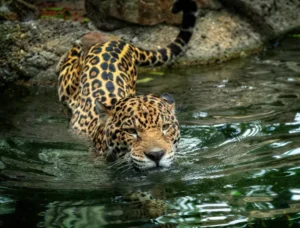
Most cats avoid water—but not jaguars. These big cats are strong swimmers and are often found near rivers and lakes. In fact, their ideal habitats include dense forests, access to water, and plenty of prey. They’re also known to live in swamps, grasslands, and dry scrublands. Among the big cats, jaguars are the most water-loving species.
3. Males Roam Larger Territories
In Mexico, male jaguars occupy territories of about 100 square kilometers, which is more than double the size of female territories (around 46 sq km). Males also cover more ground daily—up to 2,600 meters compared to females’ 2,000 meters—especially during the dry season. They spend a lot of time marking their territory using roars, scent marking, and scraping trees.
4. They Prefer a Solitary Life
Jaguars are solitary by nature. They patrol and defend their territory alone, except during mating season. Females raise their cubs on their own, and by around two years old, young jaguars begin hunting for themselves.
5. People Often Confuse Them with Leopards
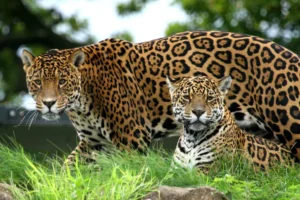
At first glance, jaguars and leopards can look similar: both have golden coats with dark spots. But look closer, and you’ll see that jaguar spots (called rosettes) often have smaller dots inside them. Jaguars also have a more muscular build, a broader head, and shorter legs. And while jaguars live in the Americas, leopards are found in Africa and Asia.
6. They Hunt Day and Night
Jaguars are both diurnal and nocturnal, though they tend to be more active at night. Thanks to their excellent night vision and camouflage, they can silently stalk prey in the dark. A study in Belize found that 70% of jaguar activity occurred at night, while Venezuelan jaguars were active 40–60% of the time after sundown.
7. They’ve Inspired Legends
It’s no surprise that such a stealthy, powerful predator has a rich legacy in folklore. The word “jaguar” comes from the Tupi-Guarani word yaguara, meaning “wild beast that overcomes its prey in a single bound.” These cats were revered in many South American cultures, and also held spiritual significance in Native American tribes of the American Southwest, including the Pueblo and Pima peoples.
8. Jaguars Can Roar
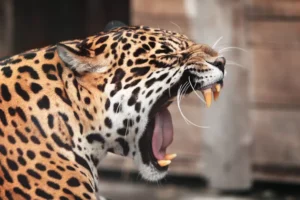
Like lions and tigers, jaguars can roar thanks to a unique ligament (called the epihyoideum) in their throat. This ligament, instead of a bone, allows them to produce deep, resonant calls. Males tend to roar louder, especially when defending territory or during mating season. Sadly, poachers have learned to mimic these calls to lure jaguars.
9. They Eat Just About Anything
Jaguars are opportunistic hunters. Their diet includes mammals, reptiles, birds, and even livestock. They usually hunt on the ground but can also leap from trees to ambush prey. Larger kills are often consumed over a few days to conserve energy.
10. Their Tongues Are Built for Eating
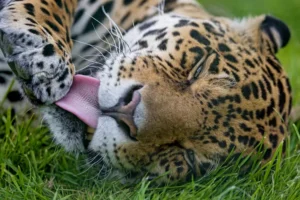
Jaguars’ tongues are covered in tiny, backward-facing spines called papillae, which help them scrape meat off bones and keep themselves clean. These rough tongues play an essential role in their grooming and eating habits.
11. Black Jaguars Are More Common Than You’d Think
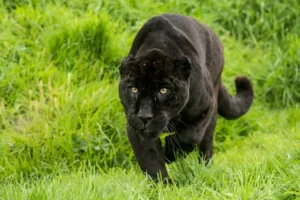
About 10% of jaguars are born with a dominant gene that gives them a black coat—a condition known as melanism. These “black panthers” aren’t a separate species but simply jaguars with dark fur. Their rosettes are still visible up close. A 2020 study found that melanistic jaguars were more common in the dense forests of Costa Rica, likely because the darker coloring offers better camouflage.
